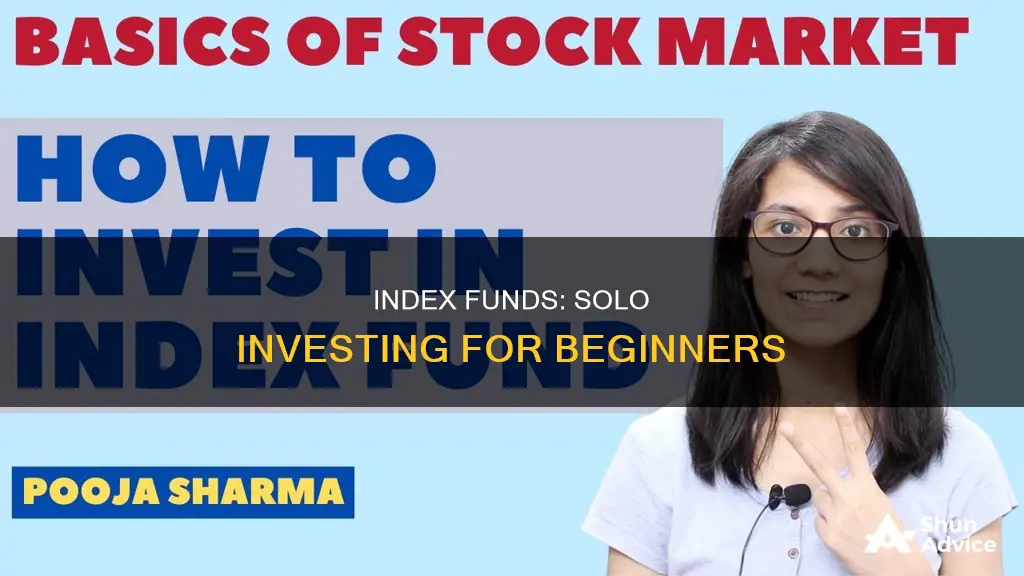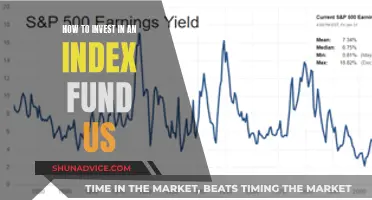
Index funds are a type of investment vehicle that tracks a market index such as the S&P 500 or the Russell 2000. They are designed to mirror the performance of a designated stock market index, aiming to match its returns. Index funds are passively managed, meaning that investing decisions are based on trying to match the index. They are a low-cost, easy way to build wealth and are therefore a great investment option for those looking to grow their money.
| Characteristics | Values |
|---|---|
| Type of investment vehicle | Mutual fund or exchange-traded fund (ETF) |
| Investment goal | To match the returns of a specific market index |
| Investment strategy | Passive |
| Investment costs | Low fees |
| Investment risk | Low risk |
| Investment performance | Often perform very well |
| Investment research | Easy to research |
| Investment purchase | Direct from a mutual fund company or a brokerage |
What You'll Learn

Understand different types of index funds
Index funds are a great investment option for those looking to build wealth over the long term. They are a type of investment fund that tracks the performance of a particular market index, such as the S&P 500 or the Dow Jones Industrial Average. These indexes are made up of companies that represent a specific sector or size within the financial market.
There are several types of index funds available, each offering a different level of diversification and risk. Here are some of the most common types of index funds:
- Broad Market Index Funds: These funds aim to capture the performance of a large segment of the investable stock market. They provide exposure to stocks across different sectors and market capitalizations, making them a great option for those seeking low-cost, diversified investments. Examples include the Vanguard Total Stock Market ETF and the Schwab U.S. Broad Market ETF.
- Market Capitalization Index Funds: These funds invest based on specific market capitalization ranges. Market capitalization refers to the total value of a company's outstanding shares. Large-cap funds, such as those tracking the S&P 500, focus on companies with market capitalizations above $10 billion, while small-cap funds target companies with capitalizations below $2 billion. The Fidelity 500 Index Fund is an example of a large-cap fund.
- Equal Weight Index Funds: Unlike market capitalization-weighted funds, equal weight index funds give the same weight to each stock in the index. For example, if an index has 50 stocks, each stock will have a weight of 2%. This approach helps to diversify the portfolio and reduce the risk of any single stock dominating the fund's performance. Popular equal weight funds include the Invesco S&P 500 Equal Weight ETF and the Direxion Nasdaq-100 Equal Weighted Index Shares.
- Fixed Income/Debt Index Funds: These funds invest in bonds rather than stocks. They track bond indices in the same way that stock index funds track stock market indices, allowing for lower expense ratios compared to actively managed funds. Examples of fixed-income index funds include the Vanguard Long-Term Bond ETF and the iShares 1-5 Year Investment Grade Corporate Bond ETF.
- Sector-Based Index Funds: These funds focus on specific sectors or industries, such as technology, healthcare, or financials. They are a great way to express an investment opinion on a particular area of the economy without having to research individual securities. Examples include the Consumer Discretionary Select Sector SPDR Fund and the Fidelity MSCI Financials Index ETF.
- International Index Funds: International index funds provide exposure to geographic areas outside of the investor's home country, such as emerging markets or developed markets in Europe or Asia. These funds offer a simple way to diversify your portfolio internationally. Examples include the Vanguard FTSE Emerging Markets ETF and the iShares Core MSCI Total International Stock ETF.
- Socially Responsible Index Funds: These funds have gained popularity as investors increasingly consider the environmental, social, and governance (ESG) impact of their investments. Socially responsible index funds may include companies with a strong focus on ESG issues or exclude companies involved in industries such as firearms, alcohol, or tobacco. Examples include the Vanguard ESG U.S. Stock ETF and the iShares Global Clean Energy ETF.
Smart Ways to Gift Investment Funds to Your Kids
You may want to see also

Choose a brokerage account
You can purchase index funds in almost every investment account type, such as a brokerage account, IRA, health savings account (HSA), or 401(k).
When choosing a brokerage account, you should consider the following:
- Fund selection: Do you want to purchase index funds from various fund families? While the big mutual fund companies carry some of their competitors' funds, the selection may be more limited than what's available from a discount broker.
- Convenience: Find a single provider that can accommodate all your needs. For example, if you're just going to invest in mutual funds (or even a mix of funds and stocks), a mutual fund company may be able to serve as your investment hub. But if you require sophisticated stock research and screening tools, a discount broker that also sells the index funds you want may be better.
- Trading costs: If the commission or transaction fee isn't waived, consider how much a broker or fund company charges to buy or sell the index fund. Mutual fund commissions are typically higher than stock trading commissions, about $20 or more. Compare that with less than $10 a trade for stocks and ETFs.
- Impact investing: Want your investment to make a difference outside your portfolio? Some funds target companies with a focus on environmental or social justice causes.
- Commission-free options: Do they offer no-transaction-fee mutual funds or commission-free ETFs?
- Fidelity Investments
- TD Ameritrade
- Charles Schwab
- Robinhood
The type of account you need will depend on your investment goals. For instance, preparing for retirement requires a different kind of account than saving for your child's education.
- Saving for retirement: Employer-sponsored retirement plans (e.g. 401(k)s, 403(b)s, and 457(b)s), traditional IRAs, or Roth IRAs.
- Saving for a child's education: 529 plans, UGMA/UTMA custodial accounts, or custodial Roth IRAs.
- Saving for health expenses: Health Savings Account (HSA).
- Saving for something else: Taxable brokerage account.
Tax-Exempt Bond Funds: When to Invest for Maximum Returns
You may want to see also

Decide on your investment goals
Setting clear investment goals is crucial to achieving financial success. Here are some detailed guidelines to help you decide on your investment goals:
Understand the Intersection of Life and Investment Goals
Your investment goals are closely tied to your life plan and outlook. Age, income, and outlook are essential factors to consider. Age can be divided into three categories: young and starting, middle-aged and family-oriented, or old and self-directed. Income is a natural starting point, as you can't invest what you don't have. Outlook refers to your life choices, such as family planning, career expectations, and retirement plans.
Set Up an Investment Goals Workflow
Investment goals should address three key themes: their intersection with your life plan, the accountability they create, and the motivation they provide. Establish a workflow that forces you to think about sacrifices, budget balancing, and long-range planning. Use monthly or quarterly statements to review progress and make adjustments as needed.
Apply the SMART Format
The Australian Investors Association recommends using the SMART format when setting investment goals:
- Specific: Make each goal clear and specific.
- Measurable: Frame goals to track progress and determine if you're on target.
- Achievable: Ensure the goals are attainable and realistic.
- Relevant: Ensure the goals align with your life and are realistic.
- Time-based: Assign a timeframe to each goal for tracking progress.
Group Your Goals by Time Horizons
Segment your goals into short-term, medium-term, and long-term categories. Short-term goals are those you want to achieve in the next couple of years, such as a vacation or a down payment on a car. Medium-term goals might include a down payment on a house or a wedding and are likely to be larger and require more time. Long-term goals are those beyond five years, such as retirement or saving for a child's education.
Choose Investments That Align with Your Goals
Select investments that match the time horizon of your goals. For short-term goals, focus on preserving your money with low-risk options like money market funds and high-yield savings accounts. For medium-term goals, you may be able to take on more risk, potentially allocating a small portion of your portfolio to high-quality stocks or dividend-paying stocks. For long-term goals, consider stocks as part of a diversified portfolio, as you'll have more time to make up for any losses.
Mutual Fund Tax Strategies: Secrets to Tax-Free Investing
You may want to see also

Research index funds
When researching index funds, it's important to consider several factors. Here are some key points to keep in mind:
- Company size and capitalisation: Index funds can track small, medium-sized, or large companies, known as small-, mid-, or large-cap indexes. This is an important factor to consider as it can impact the level of risk and potential returns associated with the fund.
- Geography: Some index funds focus on stocks that trade on foreign exchanges or a combination of international exchanges, offering exposure to different markets and economies.
- Business sector or industry: Different index funds focus on specific sectors or industries, such as consumer goods, technology, or health-related businesses. This allows investors to target specific areas of interest or expertise.
- Asset type: Index funds can track bonds, commodities, or cash, in addition to stocks. This provides flexibility for investors with different risk tolerances and investment goals.
- Market opportunities: Some index funds focus on emerging markets or other growing sectors, allowing investors to capitalise on potential growth opportunities.
- Fees and costs: Index funds typically have lower fees and costs compared to actively managed funds, but it's important to compare the expense ratios and other fees associated with different funds.
- Performance and tracking: Compare the performance of different index funds and how closely they track their underlying indexes. This can be done by reviewing the fund's returns and comparing them to the benchmark index's performance.
- Fund size and liquidity: Larger funds often offer more liquidity and lower trading costs, but it's important to compare the trading costs and liquidity of different funds to assess how easy it would be to liquidate your investment if needed.
- Tax implications: Consider the tax implications of investing in index funds, especially if held outside of tax-advantaged accounts. Some funds may trigger capital gains taxes, impacting your overall returns.
SS Funds: Where Are Your Contributions Invested?
You may want to see also

Set up a regular investment plan
Setting up a regular investment plan is a great way to build wealth over time. Here are some steps to help you get started:
Define your investment goals and risk tolerance:
Before investing in index funds, it is important to understand your financial goals and risk tolerance. Are you saving for retirement, education, or health expenses? Each goal may require a different type of account and investment strategy. For example, if you are saving for retirement, you may prefer a tax-advantaged account like a 401(k) or IRA, whereas if you are saving for your child's education, a 529 plan might be more suitable.
Choose the right index funds:
There are various types of index funds available, such as broad market funds, sector funds, domestic funds, international funds, and bond funds. Consider your investment objectives and the level of risk you are comfortable with. For example, sector funds can provide targeted exposure to specific industries but may be riskier than broad market funds.
Determine your investment amount and frequency:
Calculate how much you can comfortably invest in index funds while maintaining an emergency fund and covering essential expenses. Some funds have investment minimums, so ensure you meet those requirements. Consider making regular contributions to your index funds through a dollar-cost averaging strategy, which can help manage risk and maximize returns over time.
Choose a brokerage or investment platform:
You can purchase index funds through a brokerage account, directly from an index fund provider, or via an investment app or robo-advisor. Compare the fees, fund selections, and features offered by different platforms to find one that aligns with your needs. For example, some brokerages may charge transaction fees for buying or selling index funds, while others may offer commission-free trading options.
Monitor and rebalance your portfolio:
While index funds are relatively hands-off, it is important to periodically check in on your investments to ensure they are performing as expected. Consider reviewing your portfolio at least annually and rebalancing it to ensure it remains aligned with your investment goals and risk tolerance.
By following these steps, you can set up a regular investment plan to help you achieve your financial goals through index funds. Remember to stay disciplined and consistent with your contributions, and you'll be well on your way to building your wealth over the long term.
Property Fund Investment: A Guide to Getting Started
You may want to see also
Frequently asked questions
An index fund is a type of investment vehicle or mutual fund that tracks a market index, such as the S&P 500, and aims to match its performance. Index funds are passively managed, meaning that investment decisions are based on trying to match the index.
Index funds are a low-cost, easy way to build wealth. They are also highly diversified, lowering your overall risk, and tend to outperform actively managed funds over the long term.
When choosing an index fund, consider your investment goals and risk tolerance. Look at the fund's prospectus or research page to understand which index it tracks and whether it aligns with your goals. Compare expense ratios and tax-cost ratios across different funds, as these fees can eat into your returns.
You can buy index funds through a brokerage account, directly from an index fund provider, or through certain investment apps. You will need to open an investment account and fund it before making your first purchase. Some common investment accounts include employer-sponsored retirement plans, individual retirement accounts (IRAs), and taxable brokerage accounts.







